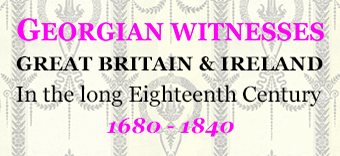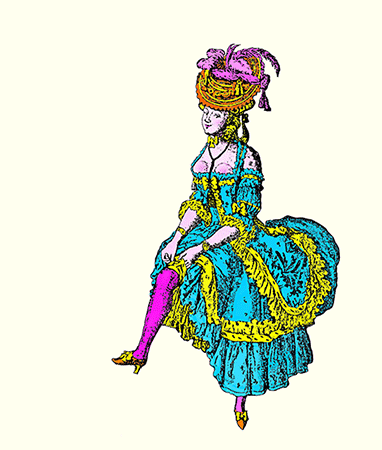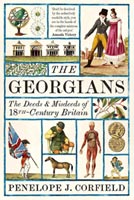Georgian Witnesses
6 / GEORGIAN TESTAMENTS TO THE VARIEGATED ARTS OF LOVE (AND SELF-KNOWLEDGE)
NINE EXAMPLES OF THE DIVERSITY OF GEORGIAN SEXUAL EXPLORATIONS
6.1 A CLASSIC EROTIC NOVEL
John Cleland (1709 – 89), Memoirs of a Woman of Pleasure, always known as Fanny Hill (1748): a notorious erotic novel, long banned, which explores the variety of sexual pleasures without prudishness, crudity, or moralising. The text, written by a man, purports to be the autobiography of a young woman; and it is sensitive to female sexual pleasures.
Near the start, the text offers the following statement from ‘Fanny’ (the name being a popular synonym for a woman’s private parts): ‘Hating, as I mortally do, all long unnecessary prefaces, I shall give you good quarter in this, and use no further apology than to prepare you for seeing the loose part of my life, wrote with the same liberty that I led it. Truth! stark, naked truth is the word.’
6.2 A SCANDALOUS CLUB FOR (MALE) SEXUAL LIBERTINES
Sir Francis Dashwood (1708 – 81) organized the most famous though not the first private society of libertines, taking the name of The Hell-Fire Club (launched c.1749; continuing to 1760 or perhaps 1766). Its members included aristocrats, plutocrats, merchants, politicians, and a son of the then Archbishop of Canterbury. They met to enjoy uninhibited sex, spiced by breaking of religious taboos, and, whilst meeting with disapproval from respectable society, attracted no personal or legal penalties.
The name of the Hell-Fire Club has been copied by raffish night-clubs world-wide, though none has become as notorious as the Georgian prototype. See Geoffrey Ashe, The Hell-Fire Clubs: A History of Anti-Morality (Stroud, 2000; 2005).
6.3 CLASSIC EROTIC ART
Thomas Rowlandson (1757* – 1827) [*often given erroneously as 1756] was a great artist of the multiple manifestations of both love and sex: drawn with a characteristic mix of tenderness and sly humour. His voluminous output included many erotic drawings, often produced for private buyers. Some of these have been lost and many were for a long time kept under wraps by their owners, who include the Royal Collection at Windsor Castle. However, the franker world of the late twentieth and early twenty-first centuries, has encouraged a reassessment of his entire oeuvre.
See both book and website, Kurt von Meier, Forbidden Erotica of Thomas Rowlandson (1970)’ and www.kurtvonmeier.com/thomas-rowlandson
6.4 A SECRETIVE COLLECTION OF BAWDY SONGS
Robert Burns (1759 – 96), The Marry Muses of Caledonia (first published 1799 – after RB’s death): contains a collection of songs and poems said to have been collected and in part written by Burns, for convivial use by a private club of Edinburgh friends. Very few copies survive of the original edition; but the collection was republished in scholarly editions in the twentieth century and is also available on the web:
http://www.robertburns.org.uk/
merrymuses.htm [adult content]
One or two of the bawdy verses parody Burns’ most famous songs, potentially giving knowledgeable revellers an extra frisson of amusement.
6.5 A PIONEERING STATEMENT IN SUPPORT OF SAME-SEX LOVE
Jeremy Bentham (1748 – 1832), Utilitarian philosopher, jurist and rationalist reformer, was an advocate of individual and economic freedoms, including free speech, equal rights for women, anti-slavery, animal rights and the decriminalisation of all forms of same-sex love. That last point was so contentious that it was hard to express in public, even though social attitudes were slowly changing. Bentham’s views were therefore kept hidden in his voluminous private essays, and not published, even in a limited form, until a century after his death. He opposed any form of legal
constraints upon what he termed ‘sexual irregularities’, provided that such actions did not fall foul of laws against violence and coercion. See J. Bentham, Of Sexual Irregularities (Oxford, 2014), ed. P. Schofield, C. Pease-Watkin and M. Quinn; and strong review by Faramerz Dabhoiwala in The Guardian online (26 June 2014)
www.theguardian.com/books/2014/jun/26/sexual-irregularities-morality-jeremy-bentham-review
Bentham believed that: ‘Every law is an infraction of liberty’, hence legal penalties should be kept to a minimum and imposed only for matters of overriding collective importance.
6.6 A CODED BUT FRANK TESTIMONY OF A LESBIAN LIFE Anne Lister (1791 – 1840),Yorkshire landowner, traveller, lesbian and coded diarist, kept a private account of her life and active love for women. Her massive diaries, once decoded, were initially thought to be a hoax, since their material was so graphic and intimate. However, since their scholarly authentication, the diaries have now been used as the basis for TV dramatisations. See I Know My Own Heart: The Diaries of Anne Lister, 1791 – 1840 (1998); No Priest but Love: Excerpts from the Diaries of Anne Lister (1992), both ed. H. Whitbread; and Anne Lister’s Secret Diary for 1817, ed. P. Hughes (2015) A rainbow plaque has now been installed on Holy Trinity Church, York, as the venue where in 1834 Anne Lister and Ann Walker exchanged vows (without legal recognition), making theirs the first de facto lesbian church-based marriage in England.
6.7 THE ADVENT OF THE SCANDAL MEMOIR
Harriette Wilson (1786 – 1845), courtesan and memorialist, found an indirect source of power, in a male-dominated world, by ‘kissing and telling all’ in her scandalous memoirs, which are still in print. She was mistress to a number of important men in Regency England, and was most notable for her confrontation with the Duke of Wellington, who was informed that she intended to reveal details of their liaison and crisply replied: ‘Publish and be damned’. His reputation post-Waterloo was beyond challenge but Wilson nonetheless cocked a snook at the elite world of male aristocrats and politicians and asserted her right to make money from her experiences. See H. Wilson, The Memoirs of Harriette Wilson: Written by Herself (1825); also in updated edition ed. L. Blanch (1985).
The nonchalant opening sentence of her Memoirs runs as follows: ‘I shall not say how and why I became, at the age of fifteen, the mistress of the Earl of Craven.’
6.8 LORD BYRON AND THE INVENTION OF THE BYRONIC LOVER
George Gordon Byron, 6th Baron Byron, known simply as Lord Byron (1788 – 1824), was an impecunious landowner, experimental poet, and scandalous lover, whose intensely lived life fostered a legendary image of raffish sexuality. He had many affairs, including an incestuous relationship with his half-sister Augusta Leigh and discreet sexual relationships with men. He left England in 1816 to escape an unhappy marriage and substantial debts; and died in 1824, while fighting in the Greek War of Independence against the Ottoman Empire – thus becoming a Greek folk hero.
Byron was one of the leading ‘Romantic’ poets but his posthumous reputation rests, above all, upon his image as an irresistible lover, who was ‘mad, bad and dangerous to know’. See N.B. Oueijan, Lord Byron and Mythology (New York, 2020) and C. Tuite, Lord Byron and Scandalous Celebrity (New York, 2016). Lord Byron after the publication of his poem Childe Harold (1812) wrote: ‘I awoke one morning and found myself famous’, as noted in T. Moore (ed.), The Life, Letters and Journals of Lord Byron (1839).
6.9 THE DEVELOPMENT OF CONTRACEPTION FOR BOTH MEN AND WOMEN
The most common eighteenth-century protective devices were for men, and were chiefly adopted as protection against contracting venereal diseases: these sheaths were made of thin animal membranes and tied with a ribbon. The British Museum possesses one example (currently not on display) dating from c.1790 – 1810: see Museum no. 1953,0206.1.a-b. Contraceptive techniques for women in this era included the use of douches and sponges, of variable but unreliable efficacy, and/or reliance, with male aid, upon coitus interruptus. The Viennese Museum of Contraception and Abortion (MUVS) has excellent English-language documentation: see https://muvs.org/en/.
In 1823 a London society, whose members included the young John Stuart Mill, was distributing free pamphlets on contraception to working-class women. Many activists were influenced by Malthusian fears that the rising population was liable to outstrip the nation’s resources; but some, like Mill himself, were also motivated by pro-feminist impulse to help women to control their own fertility.
plus
NINE EIGHTEENTH-CENTURY NOVELS ABOUT THE QUEST FOR SELF-KNOWLEDGE AND ENDURING LOVE. A COMMON THEME IS THE CHALLENGE OF HOW TO DISTINGUISH GENUINE AFFECTION FROM LOVE OF MONEY, LOVE OF SOCIAL STATUS, LOVE OF ADMIRATION, PHYSICAL LUST, PARENTAL AND SOCIAL PRESSURES ETC
6.10 Attributed to Aphra Behn (1640 – 89), Love Letters between a Nobleman and his Sister (1684 – 7), in three parts: the ardent letters demonstrate the waxing and waning of a love affair between a nobleman, significantly named ‘Philander’, and his sister-in-law, Silvia – their growing personal attachment being deemed a scandalous case of incest, because of the clear Biblical prohibition (Leviticus 18:18) of marriage between a man and his sister-in-law, during his wife’s life-time. The shock value of the core storyline of illicit love in Part 1 then morphs into a story of attempted revenge (part 2) by Silvia, who is anguished and angered when Philander’s affections turn elsewhere. After that, Part 3 diverts into a complex mix of further love intrigues and political plotting. The story gains its impact from the clear assertion of female as well as male wishes and sexual desires. And its trail-blazing originality from its candid depiction of people’s inner emotions and complex motives.
6.11 Daniel Defoe (c.1660 – 1731), The Fortunes and Misfortunes of the Famous Moll Flanders (1722): after the success of Robinson Crusoe (1719), Defoe wrote several more novels before trying his hand at a first-person narrative, published anonymously, allowing readers to access it as an authentic female autobiography. The story was partly based upon the life of a convicted criminal, named Moll King, whom Defoe had encountered when visiting Newgate Prison; but with considerable added embellishment. Moll Flanders is born into the criminal underworld; suffers multiple misadventures in Britain and in the colony of Virginia; is married several times and has children, many of whom she has to leave in the care of others; and turns to thieving, which she undertakes with success. All these fluctuations in fortune are recounted with a calm nonchalance, including incestuous experiences – such as marrying in Virginia a man who turns out to be her brother. Finally, the tale turns to repentance, again coolly recounted; and Moll settles her affairs in Virginia before returning
to England to live in respectable penitence. The novel is emphatic about female agency, since Moll, despite the poverty into which she is born, makes her own decisions; and uses her own wiles to gain advancement. The tone is secular, although Moll officially repents. And the moral seems to be that people should get by as they can … though taking care to repent before they die. Moll is not depicted as a loveable or admirable person; at the same time, she is fully human
(warts and all) – and she was followed by a considerable number of self-reliant and amoral low-life characters in eighteenth-century literature and drama.
6.12 Samuel Richardson (1689 – 1761), Clarissa: Or the History of a Young Lady (1748): a lengthy novel which reveals the protagonists’ private thoughts by means of letters between the leading characters, the pair of potential lovers and a confidential friend apiece. Clarissa Harlowe comes from a wealthy but not aristocratic family, intent on social climbing, but she wants love, marriage and pair-bonding commitment. She jousts with her rakish aristocratic admirer, Robert Lovelace (his name carrying connotations of a hero in Restoration drama), who wants sex and possibly marriage as a very last resort. The plot is frank about their mutual dilemmas. She falls in love and is hustled into running away with him but is deceived, drugged and raped. Melodramatically, but plausibly within eighteenth-century conventions, Clarissa then falls ill and dies, in effect, from a broken heart. Lovelace affects at first to think that her illness is but the symptoms of early pregnancy. He cannot understand her anguish, since for him marriage is but an outward formality and he hopes that Clarissa will settle for living together in sin. When she dies, he is at first thunderstruck and then anguished, having failed to recognise his genuine love for her. Lovelace is then killed in a duel (again melodramatically) and dies calling upon Clarissa: ‘Let this expiate!’ It is a story of rival and incompatible desires, between a man and a woman, with additional complications from their different social positions. Richardson was determinedly and unusually frank in dramatising the conflict between sexual desire and love; and equally unflinching in sticking to an unhappy ending. An unusual novel; challenging to read because of its great length; but engrossing in its depiction of the subtleties of human hearts.
6.13 Henry Fielding (1707 – 54) The History of Tom Jones, a Foundling, usually known simply as Tom Jones (1749): picaresque social comedy as its hero, a roguish, charming, and low-born foundling, explores the vagaries and vanities of the world and eventually finds true love. The story is not much concerned with the protagonists’ inner lives but is full of adventure and sharp social observation, contrasting the uninhibited lifestyle of the backbench country squire with smoother but potentially more deceitful town ways. In addition, the omniscient unnamed narrator figure provides a genial commentary on the unfolding story, which ends happily for all the virtuous characters – and for Tom Jones whose social position was not as disastrous as initially thought, and whose youthful tendency to vice had been reformed.
6.14 Eliza Haywood (c.1693 – 1756), The History of Miss Betsy Thoughtless (1751): a frank novel not so much about the inwardness of sexual desire (although various young men try their luck at seducing Miss Betsy), but about the social and matrimonial options open to young women, especially those, who, like the central figure here, are spirited but young and thoughtless. The lengthy novel offers many reflections about the constraints upon young women while negotiating the matrimonial market; and it offers a frank exposition of the outcome of Betsy’s unhappy marriage to the abusive Mr Munden. Always portrayed as stern and morose, he turned out, as a husband, to be aggressive and violent: ‘He considered a wife no more than an upper servant, bound to study and obey in all things the will of him to whom she had given her hand’ (Bk 4, Ch.6).
Betsy Munden eventually leaves her husband; spends some time alone; and finally, a year after her husband’s repentant death, marries one of her first suitors Mr Trueworth (whose name indicates the merits which she had failed to identify). The debacle of her first marriage indicated that the courtship games remained deadly serious for women, should they make the wrong choice. Mrs Munden is not censored by the author for leaving the tyrannical Mr Munden but instead is shown as making the only rational decision available in dire circumstances. At last, having learned wisdom, the Miss-Thoughtless-of-yore, is rewarded with a happy marriage of co-equals. By no means an explicit campaigning tract for women’s rights, Haywood’s novel nonetheless puts sympathy for women’s experiences at the heart of her story; and implicitly calls for sympathy for their rights and claims, hoping for a social and moral (though not explicitly religious) awakening and the achievement of companionate love.
6.15 Fanny Burney (1752 – 1840), Evelina: Or, the History of a Young Lady’s Entrance into the World (1778): Burney published this, her first novel, anonymously, and without the knowledge of her family – although her authorship was soon revealed. It provides a semi-comedic, semi-realistic view of a young women’s entrance into wealthy London society, written in epistolary form, hence allowing the characters to express their innermost thoughts and feelings.
The scenes are set in London and the spa at Bristol Hotwells; Evelina, who has been reared in seclusion, initially makes various comic faux pas but retains her charm and dignity. The plot wheels around her potential claims to family recognition; Evelina’s mortification at the social crassness of her ‘lowly’ relatives who are in trade; and the multiple complications between her rival admirers, who range from boorish to benevolent. The twists and turns are eventually resolved with a happy ending. Evelina’s rightful social position as a country gentleman’s daughter is recogmised, which enables her to marry with clear conscience her aristocratic suitor, who is ‘the best of men’. The novel, with a lively medley of characters, had an immediate success and catapulted Burney into London literary society. In some ways, her novel was an animated update of Eliza Haywood’s Betsy Thoughtless, with more distinctive characters and set-scenes but minus the unhappy marriage.
6.16 Jane Austen (1775 – 1817), Sense and Sensibility: A Novel (1811): In this novel, published anonymously, Austen employed a programmatic title to set the scene for the adventures of Elinor Dashwood, representing cool good sense, and
her younger sister Marianne Dashwood, who is all sensibility. Yet the unfolding story is far from schematic, as Austen’s sharp eye for social context, her vivid portrayal of character, her plausible, flowing dialogue, and her witty digs at social pretension all give life to the tale. The Dashwood sisters are newly facing a life of genteel poverty, after their father’s death has left them dependent on the generosity of their half-brother, John, whose potential aid is minimised by his self-seeking wife. The sensible Elinor encourages her mother and sisters to cut their costs and to move into a modest cottage in Somerset, which they do. There follows a series of unfolding loves, rivalries, heartbreaks, and learning from hard-won experience – quietly for Elinor who does not wear her heart on her sleeve; and impetuously for Marianne, who does.
At one stage (Vol.2, Ch.6), a scene in a crowded London party indicates the up-to-date ‘modernity’ and frank, impulsive and trusting nature of Marianne, when she re-encounters the man who has paid attentive court to her in Somerset (but without proposing outright) and then disappeared. ‘Her [Marianne’s] face immediately crimsoned over, and she exclaimed in a voice of the greatest emotion:
“Good God! Willoughby, what is the meaning of this?
Have you not received my letters?
Will you not shake hands with me?”’
It’s notable, by the way, that, in this era, men – outside their very closest family circles –are addressed with formality, so that Marianne names the man she loves as ‘Willoughby’, not ‘John’. It’s also apparent that her offer of an egalitarian handshake was impulsive and modish (as the handshake between men and women was just beginning to spread) but not socially unthinkable. Women were faced with many legal and social impediments; but still had scope for social agency and choice on their own parts, especially if they had independent incomes. Austen was no feminist campaigner; but her novels celebrate the autonomy of female consciousness and each women’s right to judge. She satirises those who give priority to wealth and status without sincere affection; while challenging women to rely not upon impulse but upon steady prudence and genuine affection. As the story unfolds, Elinor’s dignified self-control – even when she fears that she has lost the man she loves – is contrasted favourably with Marianne’s incautious behaviour. But as both young women are good at heart, the story rewards them – Elinor eventually marrying her briefly lost lover, even though he has been demoted from his family inheritance; and Marianne accepting the love of a good older man (who has money), while the cad Willoughby, who has deserted Marianne to marry money, is left with an unhappy marriage and belated regrets. The success of Austen’s novels in portraying the hazards of trial and error in the quest for a suitable partner – plus her witty social satire – gave impetus to the genre of romantic novels (later known as ‘rom-coms’). Ultimately, she warns against being deceived by rank, money, handsome looks, or a plausible manner hiding an inconstant character. Living well thus requires the steady exercise of moral and personal judgment, whilst enjoying the ubiquitous social comedy generated by fallible humans.
THE NINTH NOVEL, MEANWHILE, FALLS OUTSIDE ALL CLASSIFICATIONS, BEING A ONE-OFF MASTERPIECE
6.18 Laurence Sterne (1713 – 68), The Life and Opinions of Tristram Shandy, Gentleman (1750 – 67), in nine volumes; usually known as Tristram Shandy: this novel is a comic, sometimes bawdy, narration of Shandy’s life history, told with multiple digressions. philosophical meditations, and presentational jokes. In literary style, it could be described as playfully ‘postmodernist’ before the postmodernist challenge to strict rationalism – albeit much funnier than many twentieth-century novels dubbed ‘postmodernist’. The author makes frequent references to sex by means of oblique innuendo, relying upon readers to get the message, most famously in Shandy’s opening account of his conception.
‘“Pray my dear”, quoth my mother,
“have you not forgot to wind up the clock?”
“Good G–!” cried my father,
making an exclamation,
but taking care to moderate his voice at the same time.
“Did ever woman, since the creation of the world,
interrupt a man with such a silly question?”
“Pray, what was your father saying?” – “Nothing”.’
After that opening salvo, the novel progresses and digresses, with Tristram Shandy’s actual birth happening halfway through. The moral universe of the novel is shown as subject to accident and chance. including potential sexual adventures that go awry, as when Shandy’s gentle and unworldly Uncle Toby repeatedly evades the amorous advances of the Widow Wadman. Above all, the book exudes a generic love for humanity; and an explicit opposition to slavery, with sympathy for Africans who had suffered persecution. Sterne was one of the first eighteenth-century intellectuals to take a public stance against the slave trade.




